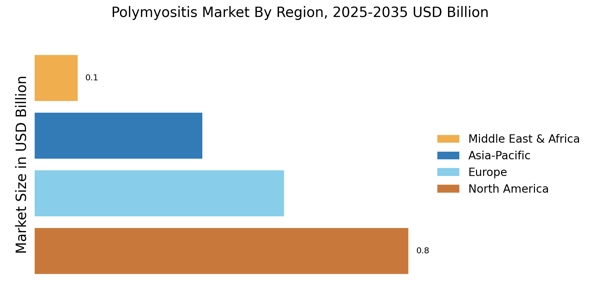Increased Awareness and Advocacy
Increased awareness and advocacy for polymyositis are driving factors in the Polymyositis Market. Patient advocacy groups and healthcare organizations are actively working to educate the public and healthcare professionals about the disease, its symptoms, and the importance of early intervention. This heightened awareness is likely to lead to more individuals seeking medical attention, thereby increasing the diagnosed population. Furthermore, advocacy efforts are pushing for better access to treatments and support services, which could enhance the overall quality of care for patients. As awareness campaigns gain momentum, the Polymyositis Market is expected to benefit from a more informed patient base and improved healthcare policies.
Rising Incidence of Polymyositis
The increasing incidence of polymyositis is a notable driver in the Polymyositis Market. Recent epidemiological studies indicate that the prevalence of polymyositis is on the rise, with estimates suggesting that it affects approximately 5 to 10 individuals per 100,000 people. This growing patient population necessitates enhanced healthcare services and treatment options, thereby propelling market growth. As awareness of autoimmune diseases expands, more individuals are being diagnosed, which further contributes to the demand for effective therapies. The rise in incidence is likely to stimulate research and development efforts, leading to innovative treatment modalities that could reshape the Polymyositis Market.
Emergence of Personalized Medicine
The emergence of personalized medicine is reshaping the landscape of the Polymyositis Market. Tailored treatment approaches that consider individual patient characteristics, including genetic profiles and disease severity, are becoming more prevalent. This shift towards personalized medicine is supported by advancements in genomics and biotechnology, which enable healthcare providers to develop customized treatment plans. The market for personalized therapies is anticipated to grow significantly, with projections indicating a potential increase in market share for targeted therapies in the autoimmune disease sector. As personalized medicine continues to evolve, it is likely to enhance treatment efficacy and patient satisfaction within the Polymyositis Market.
Advancements in Diagnostic Technologies
Advancements in diagnostic technologies are significantly influencing the Polymyositis Market. Enhanced imaging techniques, such as MRI and ultrasound, along with improved laboratory tests, facilitate earlier and more accurate diagnosis of polymyositis. This is crucial, as timely diagnosis can lead to better patient outcomes and more effective treatment strategies. The market for diagnostic tools is projected to grow, with estimates indicating a compound annual growth rate of around 7% over the next few years. As healthcare providers increasingly adopt these advanced diagnostic methods, the demand for related services and products in the Polymyositis Market is expected to rise, fostering a more proactive approach to managing the disease.
Growing Investment in Research and Development
The growing investment in research and development (R&D) is a pivotal driver for the Polymyositis Market. Pharmaceutical companies and research institutions are increasingly allocating resources to explore novel therapeutic options for polymyositis. This trend is underscored by the fact that The Polymyositis Market is projected to reach USD 100 billion by 2026, with a significant portion dedicated to conditions like polymyositis. The focus on R&D not only aims to enhance existing treatment protocols but also seeks to discover new biologics and targeted therapies that could revolutionize patient care. As funding for R&D continues to expand, the Polymyositis Market is likely to experience substantial growth.


















Leave a Comment